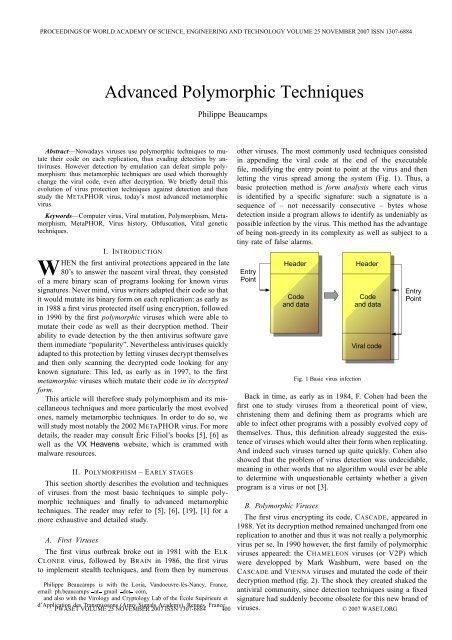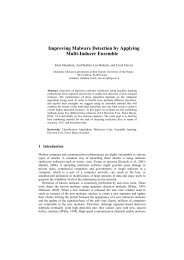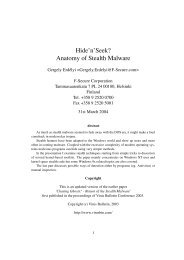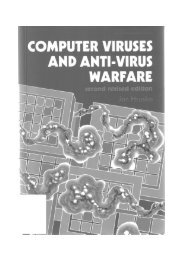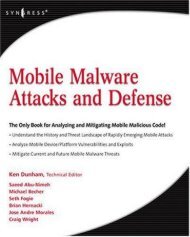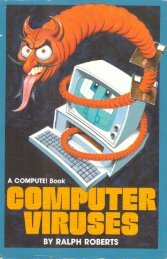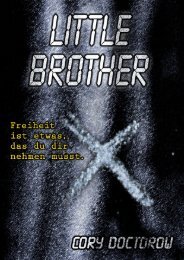Advanced Polymorphic Techniques.pdf - adamas.ai
Advanced Polymorphic Techniques.pdf - adamas.ai
Advanced Polymorphic Techniques.pdf - adamas.ai
You also want an ePaper? Increase the reach of your titles
YUMPU automatically turns print PDFs into web optimized ePapers that Google loves.
PROCEEDINGS OF WORLD ACADEMY OF SCIENCE, ENGINEERING AND TECHNOLOGY VOLUME 25 NOVEMBER 2007 ISSN 1307-6884<strong>Advanced</strong> <strong>Polymorphic</strong> <strong>Techniques</strong>Philippe BeaucampsAbstract—Nowadays viruses use polymorphic techniques to mutatetheir code on each replication, thus evading detection by antiviruses.However detection by emulation can defeat simple polymorphism:thus metamorphic techniques are used which thoroughlychange the viral code, even after decryption. We briefly det<strong>ai</strong>l thisevolution of virus protection techniques ag<strong>ai</strong>nst detection and thenstudy the METAPHOR virus, today’s most advanced metamorphicvirus.Keywords—Computer virus, Viral mutation, Polymorphism, Metamorphism,MetaPHOR, Virus history, Obfuscation, Viral genetictechniques.I. INTRODUCTIONWHEN the first antiviral protections appeared in the late80’s to answer the nascent viral threat, they consistedof a mere binary scan of programs looking for known virussignatures. Never mind, virus writers adapted their code so thatit would mutate its binary form on each replication: as early asin 1988 a first virus protected itself using encryption, followedin 1990 by the first polymorphic viruses which were able tomutate their code as well as their decryption method. Theirability to evade detection by the then antivirus software gavethem immediate “popularity”. Nevertheless antiviruses quicklyadapted to this protection by letting viruses decrypt themselvesand then only scanning the decrypted code looking for anyknown signature. This led, as early as in 1997, to the firstmetamorphic viruses which mutate their code in its decryptedform.This article will therefore study polymorphism and its miscellaneoustechniques and more particularly the most evolvedones, namely metamorphic techniques. In order to do so, wewill study most notably the 2002 METAPHOR virus. For moredet<strong>ai</strong>ls, the reader may consult Éric Filiol’s books [5], [6] aswell as the VX Heavens website, which is crammed withmalware resources.II. POLYMORPHISM –EARLY STAGESThis section shortly describes the evolution and techniquesof viruses from the most basic techniques to simple polymorphictechniques and finally to advanced metamorphictechniques. The reader may refer to [5], [6], [19], [1] for amore exhaustive and det<strong>ai</strong>led study.A. First VirusesThe first virus outbreak broke out in 1981 with the ELKCLONER virus, followed by BRAIN in 1986, the first virusto implement stealth techniques, and from then by numerousPhilippe Beaucamps is with the Loria, Vandoeuvre-lès-Nancy, France,em<strong>ai</strong>l: ph.beaucamps at gm<strong>ai</strong>l dot com,and also with the Virology and Cryptology Lab of the École Supérieure etd’Application des Transmissions (Army Signals Academy), Rennes, Franceother viruses. The most commonly used techniques consistedin appending the viral code at the end of the executablefile, modifying the entry point to point at the virus and thenletting the virus spread among the system (Fig. 1). Thus, abasic protection method is form analysis where each virusis identified by a specific signature: such a signature is asequence of – not necessarily consecutive – bytes whosedetection inside a program allows to identify as undeniably aspossible infection by the virus. This method has the advantageof being non-greedy in its complexity as well as subject to atiny rate of false alarms.Fig. 1 Basic virus infectionBack in time, as early as in 1984, F. Cohen had been thefirst one to study viruses from a theoretical point of view,christening them and defining them as programs which areable to infect other programs with a possibly evolved copy ofthemselves. Thus, this definition already suggested the existenceof viruses which would alter their form when replicating.And indeed such viruses turned up quite quickly. Cohen alsoshowed that the problem of virus detection was undecidable,meaning in other words that no algorithm would ever be ableto determine with unquestionable cert<strong>ai</strong>nty whether a givenprogram is a virus or not [3].B. <strong>Polymorphic</strong> VirusesThe first virus encrypting its code, CASCADE, appeared in1988. Yet its decryption method rem<strong>ai</strong>ned unchanged from onereplication to another and thus it was not really a polymorphicvirus per se. In 1990 however, the first family of polymorphicviruses appeared: the CHAMELEON viruses (or V2P) whichwere developped by Mark Washburn, were based on theCASCADE and VIENNA viruses and mutated the code of theirdecryption method (fig. 2). The shock they created shaked theantiviral community, since detection techniques using a fixedsignature had suddenly become obsolete for this new brand ofviruses.PWASET VOLUME 25 NOVEMBER 2007 ISSN 1307-6884 400 © 2007 WASET.ORG
PROCEEDINGS OF WORLD ACADEMY OF SCIENCE, ENGINEERING AND TECHNOLOGY VOLUME 25 NOVEMBER 2007 ISSN 1307-6884Fig. 2 <strong>Polymorphic</strong> virus infectionThe famous WHALE virus appeared the same year: itincluded polymorphism, stealth and armouring techniques andmutated in particular the code of its mutation function usingobfuscation techniques (dead code, test repetition, redundantcode,...).Then“boards”appeared,whereweresharedvirusesand e-zines, among which Phrack and 40Hex, andwherewere worked out and shared new viral techniques. Then in1992 the first polymorphic engines appeared, like MTE, TPE,NED and DAME 1 , which could be linked to the virus toproduce a polymorphic variant. They were quickly followedby the first virus creation toolkits, like VCL, PS-MPC andG2 2 , some of which including polymorphism features. Thissignalled the start of massive creation – in thousands – ofsimple and polymorphic viruses.On the antiviral community side, the answer came in 1992when Eugene Kaspersky worked out a technique now used bymost antivirus products, namely detection by code emulation.Since one could not anymore rely on the static version ofa program’s code to detect a virus, the code was run in acontrolled (emulated or sandboxed) environment on a givennumber of instructions, and periodically or in the end theaffected memory was analysed to detect the (possibly partially)decrypted viral code. Indeed, and this is the base principle ofmetamorphism, polymorphic codes had the major drawback ofalways decrypting themselves into the memory into an invariantand thus detectable form. However this detection techniquealso has the disadvantage of being quite cpu-intensive.Several techniques, called anti-emulation techniques, havebeen developped as a result by virus writers to hinder this kindof detection:• Using unusual instructions which an emulator might notsupport and interpret, or similar tricks that would preventthe virus from decrypting itself correctly or that wouldbetray the presence of an emulator.1 MUTATION ENGINE (MTE) by Dark Avenger, TRIDENTPOLYMORPHICENGINE (TPE), NUKE ENCRYPTION DEVICE (NED) and DARK ANGEL’SMULTIPLE ENCRYPTOR (DAME).2 VIRUS CONSTRUCTION LAB (VCL), PHALCON/SKISM MASS-PRODU-CED CODE GENERATOR (PS-MPC) and PHALCON/SKISM’S G2 VIRUSGENERATOR (G2).• Inserting dead code that will loop long enough to have theemulator give up on detection, relying on the prohibitivecost of emulation (this technique is used by the BISTROvirus for instance).• Random cancelling of decryption, thus running the viralcode only a random basis.• Entry Point Obscuring (EPO) techniques, which consistin avoiding executing the virus body at the very beginningof the host’s execution, but rather executing it during thehost execution or even in the end.• Using several encryption layers.• Decrypting and running the code chunk by chunk, someviruses decrypting and running only one instruction at atime (like the DARK PARANOID virus, in 2004).• Metamorphic techniques, which transform the encryptedcode.These techniques are det<strong>ai</strong>led in the literature [5], [6], [1]:some of these techniques are used by METAPHOR and weshall come back on them in the next section.Finally, we state Spinellis’s recent result [18], which establishesthe general complexity of the detection of such viruses.He shows that the problem of detecting polymorphic viruses,of bounded length, is NP-complete, by reducing to it the wellknownSAT problem of satisfiability.C. Metamorphic VirusesMetamorphic viruses are in a sense advanced polymorphicviruses: on each replication, the code to be executedcompletely mutates, without altering its functionality. Thus,encryption is not anymore necessary and, when used, thedecryption method as well as the decrypted code of the virusare different for each new generation. Figure 3 presents abasic example of infection by a metamorphic virus, on itsi eme mutation: in practice, the code is often encrypted and thedecryption routine is sometimes scattered among the host’scode (ZMIST virus for instance).Fig. 3 Metamorphic virus infection on generation iThe first metamorphic techniques made their appearancein 1997 with the TINY MUTATION COMPILER (TMC), byEnder. This virus had a compiler embedded in its body as wellas its own sources in encrypted pseudocode. On execution, thevirus decrypted its source code, inserted dead code, mixed upits code and data, and recompiled everything.PWASET VOLUME 25 NOVEMBER 2007 ISSN 1307-6884 401 © 2007 WASET.ORG
PROCEEDINGS OF WORLD ACADEMY OF SCIENCE, ENGINEERING AND TECHNOLOGY VOLUME 25 NOVEMBER 2007 ISSN 1307-6884• Branching technique;• Pseudo-Random Index Decryption (PRIDE);• Metamorphic techniques:– Dead code insertion;– Instruction modification;– Random modification and permutation of registers;– Code permutation;– Mutation of the memory access profile.B. Polymorphism in METAPHOR1) Encryption techniques: First let’s describe the miscellaneousencryption techniques which are commonly used inpolymorphic viruses (see [15] for some more det<strong>ai</strong>ls and forexamples).a) Basic encryption: The most simple ones, as wellas the most common ones, use a mere XOR (as shown inthe example), ADD or SUB encryption, with a key which israndomly generated on each replication and which is storedinside the virus data or directly inside the decryption method.The following code is a basic example of such an encryption:mov esi, offset enc_code_start; start of encrypted codemov edi, esi ; start of decrypted codemov ecx, (offset enc_code_end -offset enc_code_start) / 4 ; size in dwordsmov ebx, 6B3C728Ah ; encryption keystart:lodsd; load a dword in eaxxor eax, ebx ; decrypt itstosd; save itloop startend:jmpenc_code_startb) Sliding key encryption: One drawback of the previoustechnique is that, once the key has been chosen, each characteris encrypted in a unique way. Thus the sliding key encryptionupdates the key as the decryption progresses, either in a fixedway or for instance with the last encrypted character. Forinstance, the previous code could be modified in the followingway:...xoradd...eax, ebxebx, eaxc) Flow encryption: This method uses a key to generate akeystream of the same size as the data to encrypt. For instancethe generation of this pseudo-random keystream might useone or several linear feedback shift registers (LFSR, seesection III-D1). Some basic implementations simply duplicateas much as needed the input key. The previous code can beeasily adapted to this technique, in the case of a single register(lfsr_init initializes the register, and lfsr_next shiftsthe 32bits register, thus generating a new key):d) Encryption with permutation: The input data is simplypermutated. Permutation can occur on the scale of the wholedata, of chunks of bytes (of fixed or variable length), or evenof each byte (with the ROR instruction for instance).e) Multiple encryption: Several encryption techniquesare sequentially applied.f) Random key encryption: The data is encrypted with arandom key which is not stored for future decryption. Uponexecution, the key (as well as the encryption technique) canonly be recovered by brute force attack or cryptanalysis. Thistechnique disables any code emulation analysis. The size ofthe key space (and possibly its properties) allows to controlover the decryption time. This technique was introduced byDarkMan in 1999 in his RANDOM DECODING ALGORITHMENGINE (RDAE), which implemented several encryptiontechniques without storing the key: only the code’s CRC32checksum was stored. These techniques are det<strong>ai</strong>led in [2],[7].g) Code-dependent encryption: The binary code itself isused as the encryption key, or a combination of the code anda random key. This technique was usually used to ensurethat the code had not been modified – during an antiviralanalysis (where the code could be patched to disable someanti-debugging techniques).Upon decryption, the virus needs access to the decryptionkey(s). This key is usually directly stored in the program:inside the decryption procedure, inside the virus data or simplyrelated to the host program (for instance the key can be thehost’s filename). The case of RDA is different since the keyis retrieved by brute force. However other scenarios existwhere the key isn’t stored in the code but is inferred fromthe environment. This technique is called environmental keygeneration [16]. Here are some examples:• The key is forged from the local environment. For instance,the key is the hard disk serial number, combinedwith some random value stored in the code, etc.• The key depends on activation factors. For instance, itdepends on the current date and will only be valid duringsome predetermined period. In consequence, the virusitself will be disabled outside the valid periods.• The key is stored on a web server, a news server, etc.The most advanced implementation of this technique is theproof of concept BRADLEY virus [4]. It uses several encryptionlayers, whose keys are retrieved from the environment.The interest of such viruses from their writer’s point of view,is that they can restrict the activity of their virus geographicallyas well as temporally. Filiol also shows in [4] that, if the keyis unknown during the analysis, the cryptanalysis’s complexityis exponential (in BRADLEY’s case).As for METAPHOR, it encrypts its code with an initial...probability of 15/16 and uses an encryption method (withmov ebx, 6B3C728Ahcall lfsr_init ; init the register from the key random key) of type XOR, ADD or SUB.start:lodsdHowever, METAPHOR’s decryption method is much morecall lfsr_next ; ebx := 4 new bytes from keystreamxor eax, ebxinteresting. It uses techniques that The Mental Driller had alreadyimplemented into the TUAREG engine (TAMELESS UN-...PWASET VOLUME 25 NOVEMBER 2007 ISSN 1307-6884 403 © 2007 WASET.ORG
PROCEEDINGS OF WORLD ACADEMY OF SCIENCE, ENGINEERING AND TECHNOLOGY VOLUME 25 NOVEMBER 2007 ISSN 1307-6884PREDICTABLE ANARCHIC RELENTLESS ENCRYPTION GEN-ERATOR) and that he describes in another issue of 29A’smagazine [13], [12]. This engine combined most notably twonovel techniques, with an anti-heuristic purpose, which alsotook part in the mutation of the decryption routine. Bothtechniques, the branching technique and the PRIDE technique,are used in METAPHOR. Finally, an EPO technique is used togive control to the decryption routine: METAPHOR changesall calls to the exit function into calls to this routine.Thus, the virus only g<strong>ai</strong>ns control after execution of theprogram, which contributes to its stealth and protects it fromthe detection by emulation.2) Branching technique: A basic decryption method has astructure that often follows a common template which willtrigger an alarm in any heuristic engine, as one can see withthe examples from last section. Thus the branching techniqueallows to simulate as much as possible the behaviour of aninnocuous program. Such programs will usually sequentiallytest several conditions and, depending on the result, finallybranch on distinct paths. This technique therefore createsseveral random tests, until a given recursivity level, that willdefine an execution tree with leaves representing distinct waysto decrypt the code. Figure 4 describes the execution tree for amaximum depth of recursivity equal to 2: each terminal branchhas its own decryption code, though the final result is the same,whatever branch is taken. Thus for a depth of recursivity equalto n, 2 n decryption branches are generated.int jmp;if (recLevel >= maxLevel) { // maximum depth?insert_code ();// decryption codebuild_instr (OP_CMP, REG_ECX, code_len);// CMP ecx, code_lenjmp = insert_partial_jump (OP_JNZ); // JNZ partial_jumps [cnt_partial_jumps ++] = jmp;// update the target in the end... // call the decrypted codereturn;}recLevel ++;add_node (insert_label ()); // save the new branchif (random_boolean ()) { // test CMP or TEST?int reg, val, op;reg = get_random_register ();val = 0x80000000 | (random () & 0x3fffffff);// 0x8XYYYYYY (X < 4)build_instr (OP_CMP, reg, val); // CMP reg, valop = OP_JB + (random () & 0x5); // JB/JA/JBE/JAEjmp = build_partial_jump (op); // partial jump} else {int reg, val, op;reg = get_random_register ();val = 0x1
PROCEEDINGS OF WORLD ACADEMY OF SCIENCE, ENGINEERING AND TECHNOLOGY VOLUME 25 NOVEMBER 2007 ISSN 1307-6884As this will be det<strong>ai</strong>led in section III-C about metamorphictechniques, this code is actually an intermediate representationof the final code: once the code has been created, METAPHORgenerates the final x86 code by rewriting each instructioninto an equivalent sequence of instructions and by randomlyinserting dead code.3) PRIDE technique (Pseudo-Random Index DEcryption):The purpose of this technique is also to protect the virus froma heuristic detection. Indeed, even with the modification ofthe execution tree of the decryption procedure, it follows thefollowing common mechanism (for a basic encryption):1) data := address of a buffer inside the data section ofthe virus.2) Sequentially read data and create a new buffer, whichwill cont<strong>ai</strong>n the decrypted data.3) Give control to the new decrypted code.The second stage of this procedure, which consists insequentially reading a sequence of 1000 bytes or more inmemory, presents a high risk of heuristic alert. Therefore, thePRIDE technique consists in decrypting data in a pseudorandomorder and not anymore in a sequential order. Byte10 will be decrypted, then byte 23, then byte 7, then byte48, and so on. This memory access profile is much closerto an innocuous application’s memory access profile. In thesame time, this technique reinforces the polymorphism of thedecryption code.Here is the algorithm used for the PRIDE technique (ll.15570 – 15652 and 15827 – 15984). size_of_data is thesize of the data to be encrypted, rounded up to a power of 2.First the algorithm initializes its variables:AND CR, val’ ; val’ = ((random() &; ˜size_of_data) | (size_of_data-4)) & -4; (-> CR := (CR % size_of_code) & FFFFFFFCh)ADD IR, pride_stepAND IR, val’’ ; val’’ = ((random() &; ˜size_of_data) | (size_of_data-1)) & -1; (-> IR := IR % size_of_code)CMP CR, pride_startJNZ ; jump at a random branchFurthermore, the last instructions which update registersCR and IR (ADD CR, val and AND CR, val’ for theCR register) are permutated with each other, with the obviousrequirement that the AND instruction is executed beforeits ADD counterpart. Also, as we can see, pride_stepdetermines the “order” of decryption: when equal to 0, itsimply corresponds to a sequential decryption (starting atindex (IR ˆ pride_start)).This ends the study of polymorphic techniques in META-PHOR. Both techniques we described m<strong>ai</strong>nly <strong>ai</strong>m to impedeany detection by emulation: however, in a sense, they also havea mutation role, not anymore in the form but in the behaviour.This proximity between signatures used for form analysis andsignatures used for behaviour analysis is studied into moredet<strong>ai</strong>ls in [6].C. Metamorphism in METAPHORMETAPHOR’s metamorphic engine takes up 70% of thesource code (11000 lines in all), the rem<strong>ai</strong>ning 30% accountingfor the infection routines (20%) and the decryptor’s creationroutine (10%). This proportion isn’t uncommon: some metamorphicviruses devote up to 90% of their code to theirpride_start = (size_of_data - 4) & random (); metamorphic engine. The engine is used to mutate the virus// aligned on a dword boundary body (more precisely the part to be encrypted) as well as thepride_step = (size_of_data - 8) & random ();decryptor itself.// aligned on a qword boundarypride_key = get_random_key ();The engine works according to the following template,which The Mental Driller calls humorously accordion model:Then it initializes the registers to be used by the decryption 1) Disassembly / Depermutationroutine: CR, IR and BR. CR is the counter register and cont<strong>ai</strong>ns 2) Compressionthe sequential decryption index, IR is the index register 3) Permutationand cont<strong>ai</strong>ns the pseudo-random decryption index (XOR’ed 4) Expansionactually with CR), BR is the buffer register used as temporary 5) Reassemblystorage for encrypted data. Compared to the decryption routineOne particularity of this engine, which conceptually differentiatesit from its predecessors, is the use of an intermediatein section III-B1, we have: CR ≡ ecx, IR ≡ esi ≡ edi andBR ≡ eax. The following code is written at the beginning ofrepresentation which allows to dissociate from the complexitythe decryption routine:of the underlying processor’s instruction set and to simplify theMOV CR, pride_startmiscellaneous transformations and the code manipulation andMOV IR, val ; val = (size_of_data - 4) & random()MOV BR, val’ ; val’ = random()creation. For instance, equivalences between x86 instructionsare deferred until the reassembly stage, jumps at other codeFinally, when the decryption routine’s body must be generated(call to insert_code inside the make_branchmethod), the algorithm writes:PUSH IRinstructions are translated into a pointer perspective (that aremuch easier to manipulate, compared to offsets), etc.1) Description of the pseudo-instruction set: METAPHORuses a limited instruction set. It only considers instructionsXOR IR, CRthat are actually used by the code. Since this intermediateMOV BR, [IR + source]representation isn’t used when modifying the host code, thisXOR BR, key ; or ADD BR, +/- key; or nothing (no decryption) restriction is natural. This instruction set is organized asADD IR, destfollows:MOV [IR], BR; write the decrypted dwordPOP IR• Base instructions with 2 operands: ADD, OR, AND, SUB,ADD CR, val ; CR += [4;7]XOR, CMP, MOV and TEST.PWASET VOLUME 25 NOVEMBER 2007 ISSN 1307-6884 405 © 2007 WASET.ORG
PROCEEDINGS OF WORLD ACADEMY OF SCIENCE, ENGINEERING AND TECHNOLOGY VOLUME 25 NOVEMBER 2007 ISSN 1307-6884• Base instructions with 1 operand: PUSH, POP, Jcc, NOT,NEG, CALL and JMP.• Other instructions: SHIFT, MOVZX, LEA, RET and NOT.• Macro-instructions:– APICALL_BEGIN, APICALL_END, APICALL_STORE,which represent the instruction sequences which areused when calling a Windows API (in the case of aPE infection): since the registers to be used by thesecalls are predefined, these macro-instructions ensuretheir protection from register swapping transformations.– SET_WEIGHT which is used for “genetic” evolution(see section III-D2).– LINUX_GETPARAMS, which is similar to APICALL_BEGIN, and represents the loading of parameters intogeneral purpose registers.– LINUX_SYSCALL which represents a syscall (int80h – used to call a system function); and LINUX_SYSCALL_STORE which represents a syscall followedby the result’s saving.• Instruction used only by internal operations: Mov Mem,Mem, used during the compression stage, and INC andLITERAL_BYTE (unencoded byte to be inserted as it is)which are used during the reassembly stage.The opcode choices are motivated by the equivalent x86opcode organization and by the sake of simplifying the manipulationof instructions and the coding of transformations. Inparticular, for the first type of opcodes, the opcode itself (forinstance ADD) is encoded into bits 6..3, and the operandtypes into bits 2..0 and 7: bit 7 specifies whether theoperands are 8 bits (for instance mov al, 12h) or 32 bits(for instance mov eax, 12h) whereas bits 2..0 specifythe type of operands (Reg, Imm, etc.).Finally, a pseudo-instruction is encoded in 16 bytes:XX XX XX XX XX XX XX XX XX XX XX XX XX XX XX XXOP *--------- operands --------* LM *- instr -*OP cont<strong>ai</strong>ns the instruction opcode, on one byte. Thenthe operands are encoded (register index, memory address orimmediate value) on the following 10 bytes. Then LM (“LabelMark”) is a flag on 1 byte telling whether this instruction isthe target of a branching instruction: when this is the case,the instruction can neither be deleted nor compressed withinstructions preceding it. The last 4 bytes cont<strong>ai</strong>n a pointerwhich has miscellaneous significations along the execution:during the disassembly, it cont<strong>ai</strong>ns the address of the initialx86 instruction, during the permutation, it cont<strong>ai</strong>ns the instruction’saddress inside the non-permutated code, etc.Once the virus decrypted its code, it gives control to it. Afterinitialization of the variables and possible payload activation,it defines the form of next generation (internal organization ofthe code – where to put code, where to put data, etc.). Thenit starts the code transformation process.2) Disassembly: The x86 code is first disassembled into anintermediate representation which uses the previous instructionset. This procedure loads the intermediate code into the bufferpointed by variable InstructionTable. It also creates anarray of labels which cont<strong>ai</strong>ns all instructions which are thetarget of a branching instruction. In the end, the computedintermediate code has been depermutated and the inaccessiblecode (dead code) removed: this is actually a direct consequencefrom the routine’s algorithm.The x86 code is disassembled by following the executionflow. The algorithm uses an array, FutureLabelTable,which cont<strong>ai</strong>ns instructions which are w<strong>ai</strong>ting for their disassembly(namely these are the targets of conditional jumpsand direct calls). Here is the algorithm:• If the current instruction was already disassembled, simplyadd a JMP instruction which points at the disassembledinstruction. Then carry on disassembly withan instruction from FutureLabelTable (if any) orterminate.• Otherwise:1) If previous instructions did point at the currentinstruction, update them in order to point at the newdisassembled instruction.2) Create the new pseudo-instruction. The followingcases are more specifically distinguished:– INC and DEC instructions are replaced by theirADD and SUB counterparts: during the reassemblystage, the opposite transformation will beapplied (or not).– If this is a JMP instruction: either its targetwas already disassembled and we simply inserta JMP instruction pointing at that instruction(by creating a label), or the target has not beendisassembled yet and we insert a mere NOP.– If the instruction is a conditional jump or a directcall: if the target has been disassembled yet, addit to the w<strong>ai</strong>t array FutureLabelTable.Theninsert the corresponding branching instruction(pointing at the disassembled target, if it exists,or at the x86 target instruction).3) Finally, if this was a JMP instruction whose targethad not been disassembled yet, continue with thistarget. If the target was already disassembled, or theinstruction is a RET, continue with an instructionfrom FutureLabelTable (if any). Otherwisecontinue with the next instruction.Code permutation is carried out, as we will see, usingunconditional jumps (no “opaque predicates” or similar tricks):during the disassembly, the JMP instructionusedtojointwopermutated blocks is replaced by a NOP instruction and thedisassembly continues with the new block. Given that thepseudo-code is built in a linear way, its final shape will bethat of the depermutated code. Similarly, inaccessible codethat was inserted will never be disassembled.3) Compression: After disassembly and depermutation, thegenerated pseudocode is compressed. This cancels the expansioneffects of the previous generations, since the compressionrules are exactly the inverse of the expansion rules. There arefive kinds of rules:1) Instr -> Instr rules:• XOR Reg, -1 -> NOT Reg• SUB Reg, Imm -> ADD Reg, -ImmPWASET VOLUME 25 NOVEMBER 2007 ISSN 1307-6884 406 © 2007 WASET.ORG
PROCEEDINGS OF WORLD ACADEMY OF SCIENCE, ENGINEERING AND TECHNOLOGY VOLUME 25 NOVEMBER 2007 ISSN 1307-6884• OR Reg, 0 -> NOP• AND Reg, Reg -> CMP Reg, 0• ...2) Instr / Instr -> Instr rules:• PUSH Imm / POP Reg-> MOV Reg, Imm• MOV Mem, Imm / PUSH Mem-> PUSH Imm• OP Mem, Imm / OP Mem, Imm2-> OP Mem, (Imm OP Imm2)• NOT Reg / NEG Reg-> ADD Reg, 1• TEST X, Y / !=Jcc-> NOP• Jcc @xxx / !Jcc @xxx-> JMP @xxx• ...3) Instr / Instr / Instr -> Instr rules:• MOV Mem, Reg / OP Mem, Reg2 /Mov Reg, Mem -> OP Reg, Reg2• ...4) Instr / Instr / Instr -> Instr / Instr rules:• MOV Mem, Reg / TEST Mem, Reg2 /Jcc @xxx -> TEST Reg, Reg2 / Jcc @xxx• ...5) Macro-operations identification rules:• PUSH eax / PUSH ecx / PUSH edx-> APICALL_BEGIN• POP edx / POP ecx / POP eax-> APICALL_END• POP edx / POP ecx / POP ebx / POP eax-> LINUX_GETPARAMS• CALL Mem / MOV Mem2, eax-> CALL Mem / APICALL_STORE Mem2• INT 80h-> LINUX_SYSCALL• INT 80h / MOV Mem, eax-> LINUX_SYSCALL_STORE• PUSH Reg1 / MOV Reg1, Imm1 / MOV Reg2,Imm2 / MOV Mem, Reg2 / POP Reg1-> SET_WEIGHT Mem, Imm1, Reg1, Reg2Notation !=Jcc denotes “any opcode that is not a conditionaljump” and the notation !Jcc denotes the inverse of thelast Jcc (for instance, JA and JBE). Furthermore, some ofthese rules might not be verified in the general case, but theyare in the case of METAPHOR’s code.The algorithm is simple. It compresses the code as much aspossible. When it looks up the next instruction, it skips anyNOP instruction that is not the target of jump or a call (flagLM is set). As long as it did not reach the end of the code,it tries to compress chunks of one, two or three instructionsstarting from the current instruction: if a compression occurs,it makes a three instructions step-back and continues. Thisallows to take into account any new reduction opportunitythat might have appeared with an instruction created bythe last reduction. For the sake of simplicity, instructionsthat are deleted are simply replaced by NOP instructions.In the end, the algorithm identifies all sequences of instructionsthat correspond to macro-instructions (APICALL_*,LINUX_SYSCALL*, LINUX_GETPARAMS, SET_WEIGHT)and replaces them accordingly. Also note that, for a reduction– of any type – to occur, no instruction, except the first one,shall be the target of a jump (flag LM).The algorithm also allows to reduce sequences of operationsinto a unique operation. For instance, ADD Reg, X / SUBReg, Y will be reduced into ADD Reg, (X - Y): thesedecompositions are created during the expansion. Finally,when a Jcc instruction is replaced by a JMP instruction,the following code is deleted (NOPed) until reaching a label(instruction with LM = 1).Here is an example of compression (this code represents abasic decryption routine):test esi, val1 | nopmov [Mem], val2 | mov esi, (val2 + val3)add [Mem], val3 | noppush [Mem] | noppop esi | nopmov [Mem2], esi | mov edi, esiand esi, -1 | noppush [Mem2] | noppop edi | noppush val4 | mov ecx, val4pop [Mem3] | nopor [Mem3], 0 | nopmov ecx, [Mem3] | nopmov ebx, val5 | mov ebx, val5 XOR val6xor ebx, val6 | noplabel: |push [esi] | mov eax, [esi]or esi, 0 | noppop eax | nopmov [Mem4], eax |==> xor eax, ebxpush [Mem4] | noppop [Mem5] | nopxor [Mem5], ebx | nopmov eax, [Mem5] | nopmov [Mem6], eax | mov [edi], eaxpush [Mem6] | noppop [edi] | nopnot esi | add esi, 4neg esi | nopadd esi, 3 | nopsub edi, 0 | nopadd edi, 4 | add edi, 4mov [Mem10], 4 | sub ecx, 4and [Mem10], -1 | nopadd ecx, [Mem10] | nopmov [Mem11], ecx | cmp ecx, 0sub [Mem11], 5 | jnz labeladd [Mem11], 5 | nopjnz label | nop4) Variable reorganization: METAPHOR <strong>ai</strong>ms to mutateat the semantic level (instructions expansion / compression)and at the code level (permutation) as well as at the codebehaviour level. We already mentionned previously that it wasmutating the internal organization of the viral code. Whenthe virus g<strong>ai</strong>ns control, it allocates into memory a space of(340000h + X) bytes, where X is a random value between0h and 01F000h. This space is then organized into 5 sections(see figure 5):• Section Code cont<strong>ai</strong>ns the decrypted x86 code.• Section Buffers cont<strong>ai</strong>ns the miscellaneous arrays andbuffersusedbythevirus.• Section Data cont<strong>ai</strong>ns the virus global variables.• Section Disasm cont<strong>ai</strong>ns the disassembled code andthen the result of the expansion of the permutated code.When creating the decryption routine, it will cont<strong>ai</strong>n itspseudocode as well as the reassembled code.• La section Disasm2 is first used as a buffer, then itPWASET VOLUME 25 NOVEMBER 2007 ISSN 1307-6884 407 © 2007 WASET.ORG
PROCEEDINGS OF WORLD ACADEMY OF SCIENCE, ENGINEERING AND TECHNOLOGY VOLUME 25 NOVEMBER 2007 ISSN 1307-6884cont<strong>ai</strong>ns the result of the permutation of the compressedpseudocode, and finally it cont<strong>ai</strong>ns the reassembled code.Fig. 5 METAPHOR’s memory organization (generation 0)Before starting the mutation and replication process, sectionsare randomly permutated and each section is shiftedby a random value between 0h and 7FFFh. In the end, themaximum required size (into memory) is: 300000h + 5* 7FFFh = 340000h. Thus, upon execution, METAPHORnever has a unique memory access profile.The virus cont<strong>ai</strong>ns about 200 global variables, each of thesevariables being allocated 8 bytes inside the Data section.These variables are accessed by their offset in that section. Aregister is specifically assigned, which isn’t modified duringthe virus execution, and which cont<strong>ai</strong>ns that section’s address.During generation 0, this base register is ebp. Thus,toaccessto the contents of variable InstructionTable, whichisat offset 10h of the Data section, one uses:mov eax, [ebp + 10h]Given that this register (ebp) is strictly reserved to dataaccess, it is sufficient to spot all instructions that use it toidentify read and write accesses to a variable and to listthese very variables. Method IdentifyVariables doesthis job and replaces in each one of those instructions the offsetby the index of the associated variable. Then the variablesare shuffled: their organization inside the Data section isthus completely modified. Then, during reassembly, whenan instruction uses one of these variables, the instruction isupdated to cont<strong>ai</strong>n the new base register (initially ebp) andthe new offset of the referenced variable.Thus the memory access profile is modified. This kind oftransformation isn’t however taken to extremes. For instance,the code often reads the contents of pseudo-instructions, asin the following code excerpt (where esi and edi cont<strong>ai</strong>npseudo-instructions addresses):Mental Driller could have taken memory access profile mutationto extremes by modifying this very internal organizationof pseudo-instructions. Given the massive use of instructionsaccessing the contents of these pseudo-instructions, impactwould have been even stronger, even though the mutation ofthe organization of pseudo-instructions is quite limited (mightwe add a few padding bytes to increase mutation possibilities).Let’s note that, in this transformation’s implementation,variables are aligned on 8 bytes boundaries so that they can berandomly positionned on any one of the first 4 bytes: finally,only 4 bytes are used by a variable.5) Permutation: Once the compression is over, the enginepermutates the code by splitting it into blocks of randomsizes, between F0h and 1E0h. When doing the splitting, thefollowing breaks are avoided:• between a CALL instruction and the associated APICALL_STORE instruction;• before a JMP or a RET instruction, to avoid two consecutivejumps;• before a JMP or a Jcc instruction, in order for the compressionprocess to correctly compress any Jcc + JMPor CMP/TEST + Jcc instructions.Once the code blocks have been computed and shuffled,the new code is built (and its address saved into variablePermutationResult). A jump at the first code block isinserted at the very beginning of the code and the code blocksare linked with each other using JMP instructions, except inthe following cases:• The target block directly follows the current block.• The block’s last instruction is an unconditional jump ora return instruction.The final result shall look like:jmp @block1@block4:;-------------;; block 4 ;;-------------; (ends with a ret)@block2:;-------------;; block 2 ;;-------------;@block3:;-------------;; block 3 ;;-------------;jmp @block4@block1:;-------------;; block 1 ;;-------------;jmp @block26) Expansion: The expansion stage consists in applyingthe inverse rules from the compression stage. This methodis called on the virus compressed pseudocode and, later, onmov ecx, [esi+1] ; Get the value in ECX the decryption routine’s code.mov eax, [esi]The first step consists in randomly modifying the usedadd esi, 5and eax, 7 ; Get the register in EAX registers. A bijective transformation is applied, which takesmov [edi+1], eax ; Set the registerinto account the following requirements:mov [edi+7], ecx ; Set the value• No register should of course be transformed in ESP.This kind of access can be profiled, since the internal • The base register (initially EBP) usedtostoretheDataorganization PWASET of VOLUME an instruction 25 NOVEMBER does not 2007 mutate. ISSN 1307-6884 However The 408 section’s address (see section© III-C4) 2007 WASET.ORG should not be any
PROCEEDINGS OF WORLD ACADEMY OF SCIENCE, ENGINEERING AND TECHNOLOGY VOLUME 25 NOVEMBER 2007 ISSN 1307-6884of EAX, ECX or EDX (which are used by system calls).• The 8 bits register used by 8 bits operations in the codemust be related to a general purpose register (EAX, EBX,ECX or EDX).Then, the expansion can start: it will update registers aswell as accesses to the virus’ global variables. The expansion’sresult is stored in variable ExpansionResult. To controlthe size of expansion, a maximum level of recursivity is firstchosen: it cannot be larger than 3. Then, for each instruction,we increment the recursivity level and we randomly transformit, by using the inverse compression rules. Intermediateinstructions which are generated are also transformed. NOPinstructions are ignored in the compressed code (to avoid anuncontrolled increase of size, after several generations).When an instruction is generated, which uses a temporarymemory address, this memory address points at the Datasection and should not have been allocated for the virusglobal variables nor by any previous instruction in the currentexpansion ch<strong>ai</strong>n. The VarMarksTable array is used to markwhich addresses have been allocated. As for global variables,the allocated address is randomly aligned on one of the first 4bytes. However, this is different in the case of the decryptionroutine since the memory has not been allocated yet (witha call to malloc): the space to be used by intermediateoperations is then the data section that was allocated insidethe host file for the decryption operations.When an instruction uses an immediate value, this valueis computationally decomposed into a sequence of operationsthat finally yield the expected immediate value. This expansionis managed by method Xp_MakeComposedOPImm. Ituses operators ADD, AND, OR and XOR (the SUB operatoris randomly generated when transforming ADD instructions).Here is for instance the algorithm used to generate aMOV Dest, Imm instruction:int v1 = random (), v2 = random ();choose randomly among:* MOV Dest, v1ADD Dest, Imm - v1* MOV Dest, v1 & ImmOR Dest, ((v2 & Imm) ˆ (v1 & Imm)) | (v2 & Imm)* MOV Dest, (v2 & ˜v1) | ImmAND Dest, v1 | Imm* MOV Dest, ˜v1 | ImmAND Dest, v1 | Imm* MOV Dest, v1XOR Dest, v1 ˆ Imm* MOV Dest, ImmIn addition, dead code is inserted, with probability 1/16,after each expansion of an instruction of the compressed code(if this instruction’s opcode was a CMP, TEST, CALL orAPICALL_STORE, amereNOP is inserted):• Instructions that do nothing, like:MOV Reg, RegADD Reg, 0AND Reg, -1...NOP• Tests that always f<strong>ai</strong>l, like:CMP Reg, Reg / JNZ [RandomLabel]• Useless x86 instructions: STC, CLC.7) Reassembly: The last stage consists in assembling thepseudo-code into valid x86 code. When several translationsare possible, the algorithm chooses one at random. Also, shortjumps and long jumps are randomly used (when a short jumpis possible), and jumps at subsequent addresses are stored inarray JmpRelocationTable, in order to be updated inthe end. After completion of this stage, the code is ready forencryption and copy out in the host.D. Randomness <strong>Techniques</strong>1) Pseudo-Random Numbers Generator (PRNG): META-PHOR makes a heavy use of random numbers. It uses its ownpseudo-random numbers generator, with two seeds, seed1and seed2, which are initialized depending on the UNIX datefor seed1 and on the code’s first bytes for seed2. Thena random value is generated using the following algorithm(ror_X denotes right rotation by X bits):int random () {seed1 ˆ= (seed2 + ror_13 (seed1 + seed2));seed2 = (seed1 + ror_17(seed2)) ˆ (seed1 + seed2);return seed1 + ror_17 (seed1 ˆ seed2);}Though this may not be obvious at first sight, the secondseed is very weak, given furthermore that it is initializeddepending on the code’s first bytes which have a low randomness:thus we get, in the worst case, a cyclic generatorof 32 pseudo-random numbers (as soon as seed2 reachesvalue 0x00000000 or value 0xFFFFFFFF). For a randomseed2, a few tests allow to compute the PRNG’s periodabout 40000, which is barely better that the glibc’s generator(random () function), whose statistical properties areparticularly weak and whose period is in the order of 30000.<strong>Polymorphic</strong> viruses usually have their own pseudo-randomgenerator, often of poor quality, which protects them at leastfrom a heuristic alert due to a strong utilization of a system’sPRNG. Yet, some generators exist that are quite powerful andhave a small cost, but their use in polymorphic viruses isscarce. Here are some of them:• Linear Congruential Generator (LCG), of which thefollowing code is an implementation:unsigned int lcg_next (void) {seed *= 1664525u;seed += 1013904223u;return seed;}• Registers generaztors, like Xorshift generators (the followingexample code comes from [10]) and generatorswith linear feedback shift registers (LFSR):/* Galois’ LFSR, with taps 32 31 29 1 */unsigned int lfsrg_next (void) {static unsigned int seed = time (NULL);int i;for (i = 0; i < 32; i++) // shift 32 timesseed = (seed >> 1) ˆ(-(signed int)(seed & 1) & 0xd0000001u);PWASET VOLUME 25 NOVEMBER 2007 ISSN 1307-6884 409 © 2007 WASET.ORG
PROCEEDINGS OF WORLD ACADEMY OF SCIENCE, ENGINEERING AND TECHNOLOGY VOLUME 25 NOVEMBER 2007 ISSN 1307-6884return seed;}unsigned int xorshift128_next (void) {/* initialization with random values */static unsigned intues cannot exceed a minimal and a maximal threshold (thusthe associated probability never reaches 1 or 0)./*Returns 1 or 0, depending on the gene’s contents.x = 123456789, y = 362436069,*/z = 521288629, w = 88675123;int query_gene (int gene) {unsigned int t;int val = get_gene (gene);t = x ˆ (x > 19)) ˆ (t ˆ (t >> 8));if ((random () & 0xFF) >= val) {// return 1 and increase propension to 1}do {// minimal threshold reached?2) “Genetic” techniques: METAPHOR combines geneticif (val < 0x08) return 1;characteristics to its generator. Here is the principle. The virusif ((random () & 0x0F) > 0)cont<strong>ai</strong>ns some sort of genetic material which will have a// increase propension to 1:set_gene (gene, -- val);tendency to favour some behaviours rather than others. On} while ((random () & 0x0F) == 0);each replication, this genetic material is updated with a small // repeat with probability 1/16random variation from the preceding material.return 1;} else {For instance, a gene cont<strong>ai</strong>ns the current propension of the do {virus to encrypt its code or not: the virus initially encrypts// maximal threshold reached?its code with probability 1/16. Depending on its decision, theif (val >= 0xF8) return 0;if ((random () & 0x0F) > 0)gene will be altered in favour or in disfavour of encryption: if// increase propension to 0the virus encrypts its body, it will have next time a higher probabilityset_gene (gene, ++ val);to encrypt ag<strong>ai</strong>n its body, and conversely. Thus after a } while ((random () & 0x0F) == 0);// repeat with probability 1/16few generations, either the code will have a strong propension return 0;to encryption, or a strong propension to absence of encryption. }The propension strengh is related to the survival time (and to }the number of replications) of the virus. Thus, if the virus hasFor a more det<strong>ai</strong>lled analysis of genetic viruses, one maya strong propension to encryption, this means that most of therefer to M. Ludwig’s books [9], [8].previous generations chose encryption and survived: this iskind of an implementation of natural selection, where virusesare preys and antiviruses are predators. Thus, let’s imagine E. Detection of METAPHORthat the antivirus easily detects encrypted replications of the Analysis of METAPHORcomestoanend.Aswesaw,virus (using statistical entropy analysis for instance) but not several advanced techniques of polymorphism and of antiemulation/ anti-heuristic protection are implemented in thisunencrypted replications. In this case, encrypted replicationswill be detected before being able to replicate and increase virus. Nevertheless they’re not taken to their extremes and thustheir propension to encryption, and in the end, most of the this mutation model is still detectable, m<strong>ai</strong>nly because of thesurvivors will come from unencrypted ancestors, with a high following “weaknesses”:propension to no encryption.• The viral code’s encryption can always be identified byMETAPHOR cont<strong>ai</strong>ns a genetic material of 24 genes. Ina stastical analysis of the code [6]. Indeed, a programother words, 24 of its choices depend on its genetic historyusually has a predefined entropy profile, which showsand its survival abilities. These genes are used for instancefew variations when comparing miscellaneous executablefor:files. Encrypted data, however, have a specific entropy• Number of files to infect: initially, only 50% are infected. profile which is much more uniform, depending on the• Choice of the method of infection: position of the viral underlying encryption system, and thus is characteristiccode, EPO type, type of the system calls, etc.of an encrypted content. Same goes for compressed data.• Encryption of the viral code, or no encryption: initially, Any antivirus using this kind of analysis will most likelythe code is encrypted with probability 1/16.consider as suspect a program that cont<strong>ai</strong>ns a lot of encryptedcontent. However, several legitimate applications• Encryption method (ADD, XOR, SUB): initially, all methodshave the same probability of being chosen.use encrypted data, for the purpose of intellectual propertyprotection. This is the case of “packed” applications• Decryption routine’s code: form of the instructions, obfuscationtype, use of anti-heuristic methods, etc.(even though malware also uses packers on a regularGiven that the virus does not store any information in its basis), and this is also the case of Skype for instance.host other than its code, it must still be able to update itsgenetic material, from one generation to another. This is whereSET_WEIGHT macro-instructions come into play: they’re locatedon disassembly and, on reassembly, the “evolved” geneis used.Here is the algorithm used to update the genes (function• When the virus is executed, it compresses its code intoa form that is roughly the same from one generationto another, by conception: METAPHOR is thereforevulnerable to any form analysis that monitors memory. Aswe might have expected, this weakness can be correctedto some extent, using miscellaneous techniques that areCheckForBooleanWeight). We notice that the genes val-preferably not described here but easy to find out. AnotherPWASET VOLUME 25 NOVEMBER 2007 ISSN 1307-6884 410 © 2007 WASET.ORG
PROCEEDINGS OF WORLD ACADEMY OF SCIENCE, ENGINEERING AND TECHNOLOGY VOLUME 25 NOVEMBER 2007 ISSN 1307-6884weakness is also the immutability of METAPHOR’smutation grammar.• METAPHOR’s mutation grammar is globally simple anddoes not use any sophihsticated obfuscation tricks – thisis by conception given that the virus wants to be ableto revert effects of mutation. In other words, using moreadvanced obfuscation techniques, possibly along with theaddition of metadata into the code (as is the case withMISS LEXOTAN – see section II-C), would lead to a virus,which would be much harder to detect (speaking of itsmere detectability as well as of the complexity of itsdetectability).• Except during decryption, METAPHOR does not protectitself from behaviour analysis.É. Filiol studies into more det<strong>ai</strong>ls some aspects of META-PHOR in [6], from a theoretical point of view, and mostnotably regarding the detection barrier on which METAPHORsits astride: if it mostly inclines towards detectability, somemodifications would be sufficient to have it incline towardsthe other side (see the POC virus PBMOT). To sum up,METAPHOR is a highly advanced virus, which could be reallydangerous with a few improvements (PBMOT cert<strong>ai</strong>nly isthe most appropriate proof). Other advances, as on the fieldof functional polymorphism, would also give metamorphicviruses more sophisticated means of defence ag<strong>ai</strong>nst detection.easy). In the same time, development of rootkit techniquesdraws away attention. Yet, both threats are real, with differentmaturities, but none of them should be overlooked. Eventhough the second one is mostly implemented in worms, whichcurrently represent the most important infectious threat, andeven though it is more technical than the first one, and thuswithin the means of more hackers.All in all, if virus writers were a bit less “in a hurry”and refined their techniques, the antiviral community could bequickly overtaken. An advanced use of syntactic and functionalpolymorphism techniques, combined with advanced stealthtechniques, would theoretically make the complexity of thedetection problem prohibitive or even undecidable [6] (POCvirus PBMOT).REFERENCES[1] John Aycock. Computer Viruses and Malware. Springer, 2006.[2] Philippe Beaucamps and Éric Filiol. On the possibility of practicallyobfuscating programs – towards a unified perspective of code protection.Journal in Computer Virology, 3(1), April 2007.[3] Fred Cohen. Computer viruses - theory and experiments, 1984.[4] Éric Filiol. Strong cryptography armoured computer viruses forbiddingcode analysis: the BRADLEY virus. In Proceedings of the 14th EICARconference, May 2004.[5] Éric Filiol. Computer viruses: from theory to applications. SpringerVerlag, 2005.[6] Éric Filiol. <strong>Advanced</strong> viral techniques. Springer Verlag France, 2007.An english translation is pending, due mid 2007.[7] Kharn. Exploring RDA. .aware eZine, 1, January 2007.IV. CONCLUSION[8] Mark Ludwig. Computer Viruses, Artificial Life and Evolution. AmericanEagle Publications, Inc., 1993.If polymorphic and above all metamorphic techniques describedin this document enable viruses to protect themselves Eagle Publications, Inc., 1995.[9] Mark Ludwig. The Giant Black Book of Computer Viruses. American[10] George Marsaglia. Xorshift RNGs. Journal of Statistical Software,in a more efficient way ag<strong>ai</strong>nst detection, their sophistication 8(14), 2003.mostly stems from antiviral protection. For antiviral protection [11] The Mental Driller. METAPHOR source code. Version 1D av<strong>ai</strong>lable at:is in fact eternally submitted to two paradoxes:http://vx.netlux.org/src view.php?file=metaphor1d.zip.[12] The Mental Driller. TUAREG det<strong>ai</strong>ls and source code. Av<strong>ai</strong>lable in• The more it develops, the more viruses, worms and other 29A#5: http://vx.org.ua/29a/29A-5.html.malwares use advanced protection techniques which get [13] The Mental Driller. <strong>Advanced</strong> polymorphic engine construction. 29A,5, December 2000. Av<strong>ai</strong>lable at: http://vx.netlux.org/lib/vmd03.html.harder and harder to bypass. In a sense, it sentences [14] The Mental Driller. Metamorphism in practice or ”how i made METAitselfindirectly to its own impotence (wrt these advanced PHOR and what i’ve learnt”. 29A, 6, February 2002. Av<strong>ai</strong>lable at:techniques). Yet currently it still rem<strong>ai</strong>ns efficient, thanks http://vx.netlux.org/lib/vmd01.html.[15] MidNyte. An introduction to encryption, April 1999. Av<strong>ai</strong>lable at:to the mediocre quality of most malwares or to the complexityof the mentionned protection techniques, which [16] James Riordan and Bruce Schneier. Environmental key generationhttp://vx.netlux.org/lib/vmn{04,05,06}.html.discourages most malware writers.towards clueless agents. In Lecture Notes In Computer Science, volume1419, pages 15 – 24, 1998.• And secondly, if on one side the increase of RAM size [17] Alisa Shevchenko. The evolution of self-defense technologies inand CPU speed, as well as the upcoming of multi-core malware. Av<strong>ai</strong>lable at: http://www.net-security.org/article.php?id=1028,processors, seem to be in favour of antiviral protection, July 2007.[18] Diomidis Spinellis. Reliable identification of bounded-length viruses isit also enables malwares to use more and more complex NP-complete. IEEE Transactions on Information Theory, 49(1):280 –techniques, without having to worry about their cost. 284, January 2003.And this is all the more true as, as we told previously, [19] Peter Szor. The Art of Computer Virus Research and Defense. AddisonWesley Professional, 2005.antiviruses will always be limited in time and CPU cost,unlike malwares.Also, it should be noted that the state of the art of currentmetamorphic techniques (with viral protection purpose) isnot representative of the threat they represent. Some antiviralexperts sweep blatantly away – recently ag<strong>ai</strong>n [17] – this threat Philippe Beaucamps is a PhD student at the CNRS / LORIA in Nancy,on the pretext that it never actually proved itself except for France. He works on the modelization of viral infections, and on formal andpractical malware detection and protection.proving its own uselessness. And as a matter of fact, the history Contact address: Loria, Équipe Carte, B.P. 239, 54506 Vandoeuvre-lèsofmetamorphic viruses tends to corroborate this: there are few Nancy Cédex, Franceof them, most of which are poorly accomplished and cont<strong>ai</strong>ncritical flaws (bugs or conception flaws which make detectionPWASET VOLUME 25 NOVEMBER 2007 ISSN 1307-6884 411 © 2007 WASET.ORG


